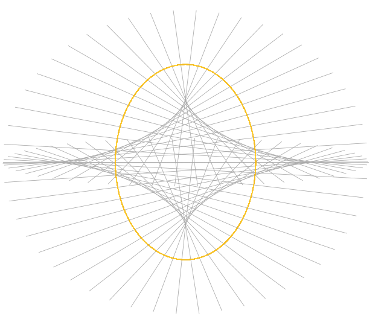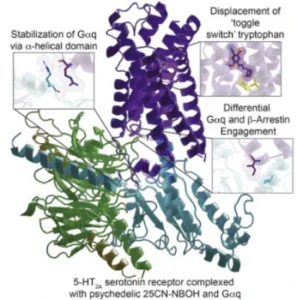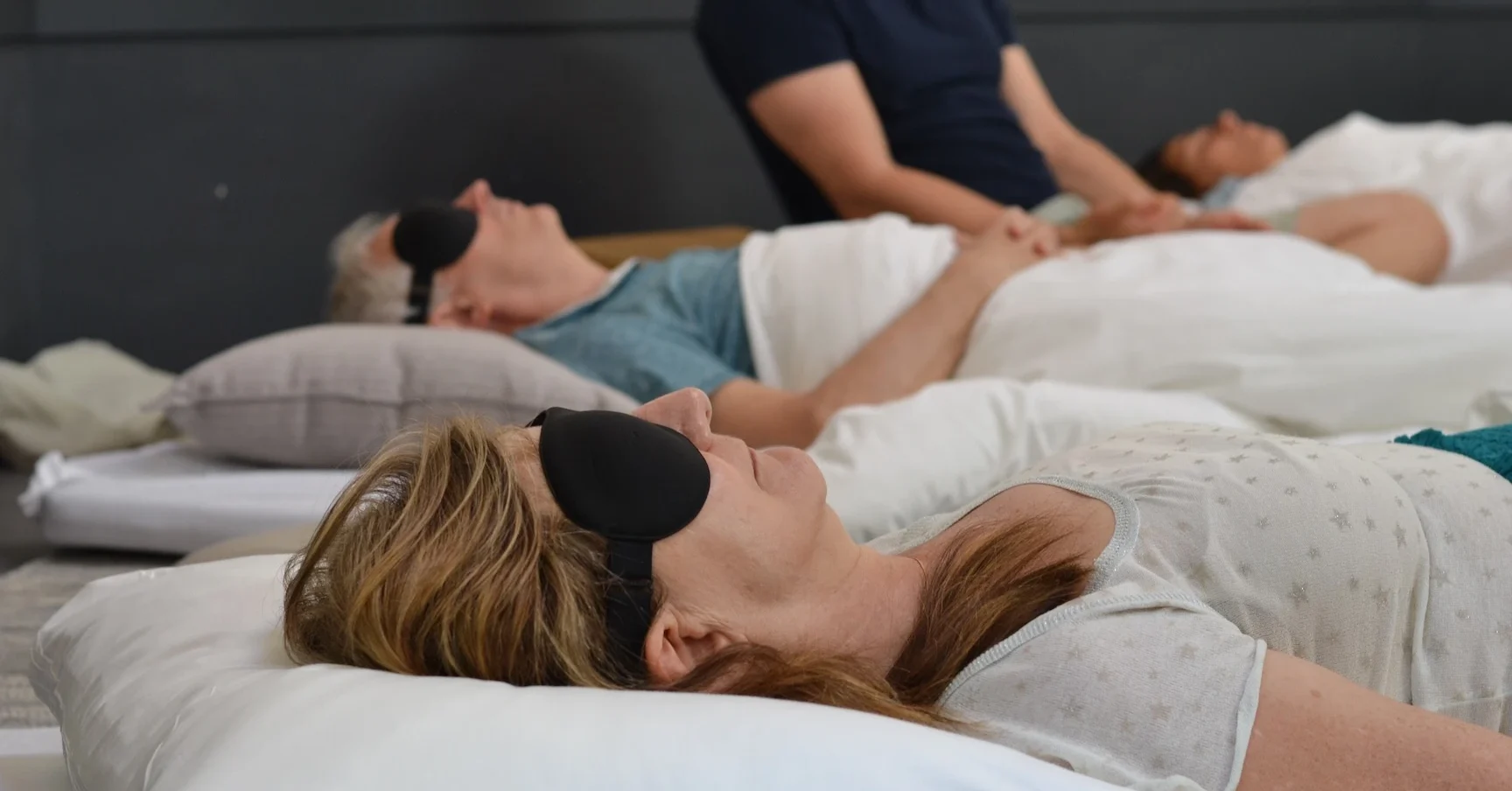Dmitrij Achelrod PhD
Contributing Author
Nino Galvez
Dmitrij Achelrod PhD
Contributing Author
Nino Galvez
What transpires in the brain under the influence of psychedelics, including LSD, psilocybin, and DMT?
Psychedelics have a profound impact on human consciousness. In this article, we delve into the neurobiological underpinnings of these mind-altering substances through a scientific lens. We’ll shed light on cutting-edge research and pivotal insights into how these drugs engage with the brain. Our exploration will mainly zero in on the most frequently used and extensively researched psychedelics, known as “serotonergic psychedelics”: Lysergic acid diethylamide (LSD), psilocybin, and N, N-dimethyltryptamine (DMT). Enter the world of neurotransmitters and “the anarchic brain”.
The Neurotransmitter Connection
The structure of a psychedelic activated 5-H2A serotonin receptor.1
Serotonin is found in our brains since it is a neurotransmitter. It modulates mood, cognition, learning, memory, and several physiological processes like vasoconstriction (the narrowing of blood vessels, through contracting small muscles in their walls).
A cadre of researchers agree that 5-HT2A receptor activation is necessary for most of the psychoactive effects of serotonergic psychedelics.2 Psychedelic substances activate those receptors by mimicking the actions of serotonin to produce the psychoactive effects.3 That is why psychedelics are referred to as (partial) agonists at that specific receptor in the brain. As you can see below, chemically, some of these compounds are very similar to serotonin.
Image Source4
How do we know what happens in the brain?
Our understanding of how psychedelics work and cause changes in our behavior has come a long way, thanks to big leaps in brain imaging techniques like electroencephalography (EEG), magnetoencephalography (MEG), and functional magnetic resonance imaging (fMRI). These methods have provided invaluable insights into the intricate interactions between brain activity and behavior in response to psychedelic substances. Below is an overview of how the use of these techniques has evolved over time. One can glean from the plot that since 2010 the use of fMRI for psilocybin and LSD has been particularly prominent.
Source: Psychedelics and fNIRS neuroimaging: exploring new opportunities. 5
Prof. Karl Friston is a pioneer in the field of fMRI and the most frequently cited neuroscientist in history. Prof. Friston and colleagues have proposed a theory elucidating the mechanics of how psychedelics function within the brain. His theory, known as ‘REBUS and the Anarchic Brain: Toward a Unified Model of the Brain Action of Psychedelics’, represents an intriguing foray into this field of study. We will jump to the REBUS model later.6
Interconnectedness in Brain Regions
Above is a fascinating depiction of the human brain under the influence of psychedelics. This simplified visualization of the interconnectivity of the brain under placebo and under psilocybin supports the idea that psilocybin disrupts the normal organization of the brain with the emergence of strong, topologically long-range functional connections that are not present in a normal state.8
So, psychedelics facilitate a significantly increased connectivity between different parts of the brain, enabling deep exploration of different states of mind.
This increased connectivity of certain brain regions might indicate that the brain is in a supercharged state. However, some studies suggest that under the influence of psychedelics, the brain’s activity, measured in blood flow, is significantly reduced. This is a puzzling finding that has created an antithesis to the REBUS model for understanding the psychedelic experience.9
Default Mode Network (DMN) – the “Executive”
Speaking about decreased activity in the brain brings us to the Default Mode Network (DMN). It is a network of interconnected brain regions that is most active when your mind is focused and concerned with yourself. When you’re daydreaming, reflecting on yourself, and thinking about your past or future, you’re tapping into the DMN. The DMN is a significant network in the brain as its associated regions consume the most blood flow10 and energy11 in the brain.
This network is vital for our sense of self. Some of your most fundamental beliefs about yourself are instantiated in the DMN. See it as the architect behind our personal narrative and identity, shaping the line between ‘self’ and ‘other’ and maintaining our self-referential thinking. Furthermore, the DMN plays a role in how we evaluate and perceive our importance and value in the world. So, it’s also our personal cheerleader. It’s involved in self-referential emotional processing, which includes our reflections on individual achievements, our status compared to others, and our general sense of self-worth. Some people have called it even our “CEO” or the “Executive” of our brain.
The DMN is a system that has attracted great research interest in major depression. Research shows that people who suffer from depression have a more active DMN. The DMN is associated with generating self-referential thoughts, negative rumination, and depressive symptoms.12
With regard to psychedelics, studies have shown that substances like LSD, psilocybin, and DMT can disrupt the typical functioning of the DMN. It turns down its activity. As we explored in the article “A Peek in the psychedelic mind”, a knob turns down when under the influence of a psychedelic. That knob can be represented by the DMN. As it turns down, it leads to experiences of ego dissolution, where the border between ‘self’ and ‘other’ begins to fade. As we saw in the article “bad trips article”, being ready to let go during the experience, perhaps of our images of self instantiated in the DMN, is key to preventing a significantly uncomfortable experience.
The reduction in self-importance and self-focus may explain why many users report feelings of unity and interconnectedness with the world around them during psychedelic experiences. Expressions like “lifting the veil” and “opening the doors of perception” to a larger experience, make more sense in this context.
Interestingly, studies have found that in meditation, especially by experienced meditators, the activity of the DMN is also significantly reduced13 – a parallel to the psychedelic experience that is being explored by researchers.14
The Psychedelic Afterglow: Short & Long-Term Brain Changes
The phenomenon of “the afterglow” following the use of psychedelic substances, typically characterized by an enduring sense of clarity, emotional enhancement, and perceptual vividness, has now found a fascinating explanation rooted in neuroscience.
According to a study by researchers at Johns Hopkins Medicine, psychedelic substances can potentially reopen “critical periods” in the brain15, these being phases when the brain demonstrates a heightened sensitivity to environmental signals, thereby influencing its development. It is assumed that the critical period is highest in childhood and adolescence and progressively narrows as we reach full adulthood. Remarkably, depending on the specific psychedelic consumed, these critical periods can be re-opened and held open from anywhere between two days to four weeks with just a single dose16.
The duration of critical period reopening correlated with the duration of each drug’s subjective effects. 17
Previous research has demonstrated critical periods playing a crucial role in diverse functions such as language acquisition in humans18, birds learning to sing19, relearning motor skills after a stroke20, or establishing ocular dominance21. It is in these critical periods, explains Associate Professor of Neuroscience at Johns Hopkins, Dr. Gül Dölen, the brain is most open to new learning, a receptivity which decreases over time.
Neuroplasticity creates a “window of opportunity”
Similar to the critical period, neuroplasticity plays a key role in the afterglow and possibility for transformation from a psychedelic experience. Neuroplasticity refers to the brain’s ability to reorganize itself and change its physical structure and functional organization in response to environmental demands, learning, and experiences. Children have higher levels of neuroplasticity than adults and therefore a better ability to learn and develop. Psychedelic substances such as LSD and psilocybin have been found to stimulate structural neuroplasticity processes at a molecular and cellular level.22 Studies show that a single dose of these substances can acutely stimulate neuroplasticity, with long-term effects after a single dose.23
Neuroplasticity and the critical period show that psychedelics create “a window of opportunity” for transformation. Research has demonstrated long-term improvements in well-being and quality of life after psychedelic use, especially in healthy individuals who are spiritually active or facing end-of-life distress.24 Studies on psilocybin and LSD have revealed lasting enhancements in well-being. One significant study by Griffiths et al. (2006) found that, in healthy individuals, two months post a psilocybin session, 79% of participants reported a moderate (50%) to very much (29%) increase in their well-being or life satisfaction. Furthermore, this beneficial effect seemed to endure, with 64% of participants reporting the same improvement at a 14-month follow-up.25 When used in the right set and setting, with guidance, and combined with purposeful preparation and integration work, the benefits of a psychedelic experience are likely to persist beyond the acute after-glow period.
A Neuroscientific Understanding of the Psychedelic Experience
Varying cultures across time and space have built their understanding of the psychedelic experience, learn about ancient use of these consciousness technologies. In the West, in 2023, the REBUS model (RElaxed Beliefs Under pSychedelics) and the notion of the ‘anarchic brain’ represent the leading theory in understanding of psychedelic experiences.
Proposed by Carhart-Harris and K. J. Friston, the REBUS model suggests that psychedelics work by relaxing the brain’s tightly held assumptions, beliefs or ‘priors’, which are our brain’s best guesses or predictions about the world based on past experiences. For instance, your belief about how a stranger will react if you make them a compliment will vastly depend on your prior experience, probably in your early life, when you approached a stranger and how they reacted back to you. This relaxation of our beliefs (priors) allows bottom-up sensory information, often suppressed by these priors, to flow more freely and influence our conscious awareness.
Furthermore, the REBUS model posits that the brain conditions induced by psychedelics, such as increased brain entropy and relaxed priors, create an ideal environment for reshaping high-level beliefs. This more flexible and open state of mind is well-suited for fostering insight and perspective change. This model of pharmacologically-assisted belief relaxation and revision could play a pivotal role in the future of mental health care, potentially augmenting the efficacy of current treatments.
For instance, instead of being mainly influenced by your beliefs (that are based on your prior experience), you can actually more deeply immerse in the present moment and observe what actually is instead of what you assumed it would be. Coming back to the idea of you giving a compliment to a stranger, the present moment experience of you seeing that the stranger appreciates your compliment and gives one back to you, might override your belief that people will laugh at you or repudiate whenever you approach them. This process of belief relaxation starts with the effect of psychedelics on the 5-HT2AR receptors and can be observed as an increase in the entropy or disorder of brain activity.
A large range of psychedelic experiences, including the surfacing of previously unconscious material into consciousness, can be explained through the REBUS model. By relaxing the grip of high-level priors, which generally summarize and suppress potential content from our minds and the external world, psychedelics release this suppressed content.
As mentioned before, valid critiques of the REBUS model have been proposed. This debate is of a metaphysical nature as it comes to face to face with the (in)famous “hard problem of consciousness” which relates to the question of whether consciousness emerges from the brain or whether it is prior to it. We save that for your own exploration.
One of these critiques comes from Dr. Bernardo Kastrup, who counters the REBUS model through his theory of analytic idealism. One of his arguments questions the proposition of entropy or disorder in the psychedelic brain because of the highly ordered nature of the psychedelic experience:
“How is it possible that experiences that people rate among the 5 most significant in their lives are associated with the brain going to sleep?”
– Bernardo Kastrup 26
Neuroscience, but one perspective on the psychedelic experience
The neuroscience of psychedelics, a rapidly evolving field, continues to shed light on our understanding of these consciousness technologies.
Techniques like EEG, MEG, and fMRI have shown that by interacting with our brain’s serotonergic system, specifically the 5-HT2A receptors, psychedelics such as LSD, psilocybin, and DMT profoundly impact brain function and structure, through neuroplasticity and the reopening of critical periods. Increased mental flexibility, creative problem-solving, and self-perception indicate the potential for therapeutic interventions and personal growth.
While significant strides have been made, let’s remember that our understanding is still evolving. What’s more, different cultures throughout time have built their understandings of what the psychedelic experience means. Integrating cognitive & neuroscientific theories like the REBUS model are ongoing attempts to deepen our understanding of these intricate processes in a comprehensive theory. We can’t solely understand these from the outside, the phenomenological/first-person perspective is key as well. To start your own exploration, we recommend this exploration of the “paradigm shift”
Please bear in mind that we do not provide medical advise and you should always seek assistance from a medical professional before making any decision about consuming psychedelics.
References

Dr. Dmitrij Achelrod,
Co-Founder Evolute Institute
Feeling inspired?
LET'S talk
We invite you to schedule a call with us. Together, we can delve into any questions you might have. We can explore whether one of our retreat programs is right for you at this time.
- Canal, C. E. (2018). Serotonergic Psychedelics: Experimental Approaches for Assessing Mechanisms of Action. Handbook of Experimental Pharmacology, 252, 227. https://doi.org/10.1007/164_2018_107
- Nichols DE. Psychedelics. Pharmacol Rev. 2016 Apr;68(2):264-355. doi: 10.1124/pr.115.011478. Erratum in: Pharmacol Rev. 2016 Apr;68(2):356. PMID: 26841800; PMCID: PMC4813425
- Kim K, Che T, Panova O, et al. Structure of a Hallucinogen-Activated Gq-Coupled 5-HT2A Serotonin Receptor. Cell 2020; 182: 1574-1588.e19
- Nichols DE. Psychedelics. Pharmacol Rev. 2016 Apr;68(2):264-355. doi: 10.1124/pr.115.011478. Erratum in: Pharmacol Rev. 2016 Apr;68(2):356. PMID: 26841800; PMCID: PMC4813425
- Felix Scholkmann, Franz X. Vollenweider,
"Psychedelics and fNIRS neuroimaging: exploring new opportunities,"
Neurophoton. 10(1) 013506 (2 December 2022) - Carhart-Harris RL, Friston KJ. REBUS and the Anarchic Brain: Toward a Unified Model of the Brain Action of Psychedelics. Pharmacol Rev. 2019 Jul;71(3):316-344. doi: 10.1124/pr.118.017160. PMID: 31221820; PMCID: PMC6588209
- Petri G, Expert P, Turkheimer F, Carhart-Harris R, Nutt D, Hellyer PJ, Vaccarino F. Homological scaffolds of brain functional networks. J R Soc Interface. 2014 Dec 6;11(101):20140873. doi: 10.1098/rsif.2014.0873. PMID: 25401177; PMCID: PMC4223908.
- Petri G, Expert P, Turkheimer F, Carhart-Harris R, Nutt D, Hellyer PJ, Vaccarino F. Homological scaffolds of brain functional networks. J R Soc Interface. 2014 Dec 6;11(101):20140873. doi: 10.1098/rsif.2014.0873. PMID: 25401177; PMCID: PMC4223908
- Carhart-Harris RL, Erritzoe D, Williams T, Stone JM, Reed LJ, Colasanti A, Tyacke RJ, Leech R, Malizia AL, Murphy K, Hobden P, Evans J, Feilding A, Wise RG, Nutt DJ. Neural correlates of the psychedelic state as determined by fMRI studies with psilocybin. Proc Natl Acad Sci U S A. 2012 Feb 7;109(6):2138-43. doi: 10.1073/pnas.1119598109. Epub 2012 Jan 23. PMID: 22308440; PMCID: PMC3277566
- Zou Q, Wu CW, Stein EA, Zang Y, Yang Y. Static and dynamic characteristics of cerebral blood flow during the resting state. Neuroimage. 2009 Nov 15;48(3):515-24. doi: 10.1016/j.neuroimage.2009.07.006. Epub 2009 Jul 14. PMID: 19607928; PMCID: PMC2739419
- Raichle ME, Snyder AZ. A default mode of brain function: a brief history of an evolving idea. Neuroimage. 2007 Oct 1;37(4):1083-90; discussion 1097-9. doi: 10.1016/j.neuroimage.2007.02.041. Epub 2007 Mar 6. PMID: 17719799
- Farb NA, Anderson AK, Bloch RT, Segal ZV. Mood-linked responses in medial prefrontal cortex predict relapse in patients with recurrent unipolar depression. Biol Psychiatry. 2011 Aug 15;70(4):366-72. doi: 10.1016/j.biopsych.2011.03.009. Epub 2011 Apr 30. PMID: 21531382; PMCID: PMC3145008
- Garrison KA, Zeffiro TA, Scheinost D, Constable RT, Brewer JA. Meditation leads to reduced default mode network activity beyond an active task. Cogn Affect Behav Neurosci. 2015 Sep;15(3):712-20. doi: 10.3758/s13415-015-0358-3. PMID: 25904238; PMCID: PMC4529365
- Wise, T., Marwood, L., Perkins, A. M., Joules, R., Lythgoe, D. J., Luh, W., Williams, S. C., Young, A. H., Cleare, A. J., & Arnone, D. (2017). Instability of default mode network connectivity in major depression: A two-sample confirmation study. Translational Psychiatry, 7(4), e1105. https://doi.org/10.1038/tp.2017.40
- Nardou, R., Sawyer, E., Song, Y. J., Wilkinson, M., De Deus, J. L., Wright, N., Lama, C., Faltin, S., Goff, L. A., L., G., & Dölen, G. (2023). Psychedelics reopen the social reward learning critical period. Nature, 618(7966), 790-798. https://doi.org/10.1038/s41586-023-06204-3
- Nardou, R., Sawyer, E., Song, Y. J., Wilkinson, M., De Deus, J. L., Wright, N., Lama, C., Faltin, S., Goff, L. A., L., G., & Dölen, G. (2023). Psychedelics reopen the social reward learning critical period. Nature, 618(7966), 790-798. https://doi.org/10.1038/s41586-023-06204-3
- Nardou, R., Sawyer, E., Song, Y. J., Wilkinson, M., De Deus, J. L., Wright, N., Lama, C., Faltin, S., Goff, L. A., L., G., & Dölen, G. (2023). Psychedelics reopen the social reward learning critical period. Nature, 618(7966), 790-798. https://doi.org/10.1038/s41586-023-06204-3
- Hartshorne JK, Tenenbaum JB, Pinker S. A critical period for second language acquisition: Evidence from 2/3 million English speakers. Cognition. 2018 Aug;177:263-277. doi: 10.1016/j.cognition.2018.04.007. Epub 2018 May 2. PMID: 29729947; PMCID: PMC6559801.
- Lorenz, K. Der Kumpan in der Umwelt des Vogels. J. Ornithol 83, 137–213 (1935).
- Dromerick AW, Geed S, Barth J, Brady K, Giannetti ML, Mitchell A, Edwardson MA, Tan MT, Zhou Y, Newport EL, Edwards DF. Critical Period After Stroke Study (CPASS): A phase II clinical trial testing an optimal time for motor recovery after stroke in humans. Proc Natl Acad Sci U S A. 2021 Sep 28;118(39):e2026676118. doi: 10.1073/pnas.2026676118. PMID: 34544853; PMCID: PMC8488696.
- Hensch TK, Quinlan EM. Critical periods in amblyopia. Vis Neurosci. 2018 Jan;35:E014. doi: 10.1017/S0952523817000219. Erratum in: Vis Neurosci. 2018 Jan;35:E024. PMID: 29905116; PMCID: PMC6047524.
- Bouso, J. C., Palhano-Fontes, F., Rodríguez-Fornells, A., Ribeiro, S., Sanches, R., Crippa, J. A. S., Hallak, J. E., De Araujo, D. B., & Riba, J. (2015). Long-term use of psychedelic drugs is associated with differences in brain structure and personality in humans. European Neuropsychopharmacology, 25(4), 483-492. https://doi.org/10.1016/j.euroneuro.2015.01.008
- Bouso, J. C., Palhano-Fontes, F., Rodríguez-Fornells, A., Ribeiro, S., Sanches, R., Crippa, J. A. S., Hallak, J. E., De Araujo, D. B., & Riba, J. (2015). Long-term use of psychedelic drugs is associated with differences in brain structure and personality in humans. European Neuropsychopharmacology, 25(4), 483-492. https://doi.org/10.1016/j.euroneuro.2015.01.008
- Griffiths R, Richards W, Johnson M, McCann U, Jesse R. Mystical-type experiences occasioned by psilocybin mediate the attribution of personal meaning and spiritual significance 14 months later. J Psychopharmacol Oxf Engl 2008; 22: 621–32
- Griffiths R, Richards W, Johnson M, McCann U, Jesse R. Mystical-type experiences occasioned by psilocybin mediate the attribution of personal meaning and spiritual significance 14 months later. J Psychopharmacol Oxf Engl 2008; 22: 621–32
- Empirical evidence for Analytic Idealism (Part 5) | Analytic Idealism with Bernardo Kastrup




